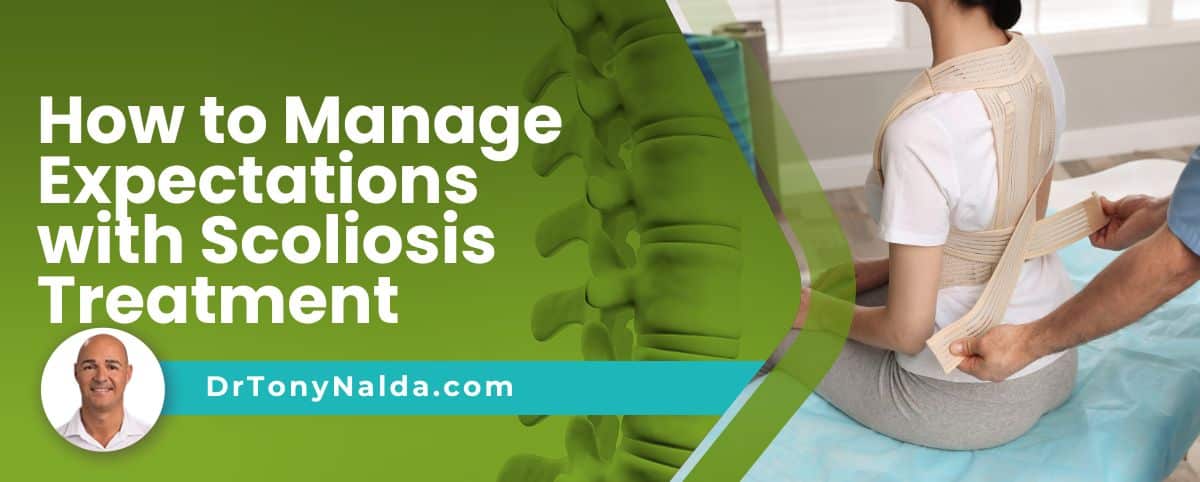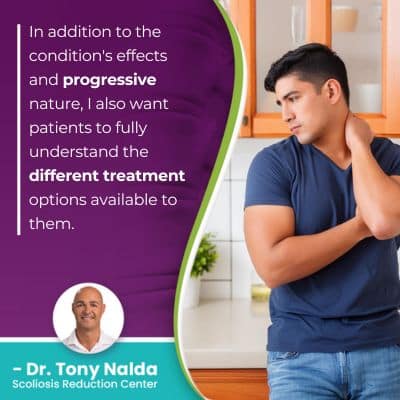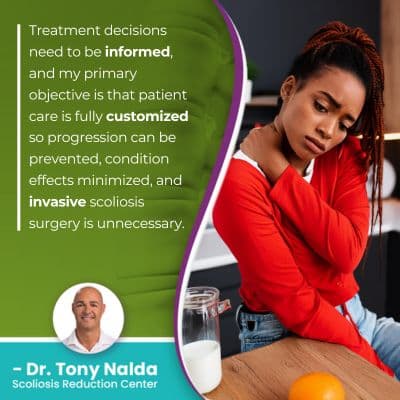How to Manage Expectations with Scoliosis Treatment

People need to be aware of how scoliosis affects the body, and how its progressive nature can make those effects worse over time. I like to educate my patients on their condition, what it will be like to live with, and the different ways to address scoliosis with treatment.
Managing expectations with scoliosis is about being informed. There are different treatment options available, and knowing how they affect the spine differently means understanding their potential outcomes and knowing what to expect.
I want my patients to fully understand their condition and the different ways to treat it, and this is reached through education and awareness.
Table of Contents
How Prevalent is Scoliosis?
Current estimates have close to seven million people living with scoliosis in the United States alone, and as the leading spinal condition among school-aged children, it warrants awareness.
Scoliosis also affects all ages; most people consider scoliosis to be a childhood condition, but the rate of scoliosis actually increases with age.
Scoliosis causes an unnatural spinal curve that bends to the side and twists to develop, and as a progressive condition, patients need to understand that where it is at the time of diagnosis doesn't mean that's where it will stay, especially if left untreated.
Understanding Scoliosis Progression
As a progressive condition, patients need to understand that the nature of scoliosis is to get worse over time, and this makes it more complex to treat, hence the benefit of a proactive treatment approach that works towards preventing progression.
Scoliosis ranges widely in severity from mild scoliosis to moderate scoliosis, severe and very severe scoliosis, and this is also the condition's progressive line.
For someone diagnosed with mild scoliosis, condition signs can be subtle, but as the nature of scoliosis is to get worse over time, virtually all cases will progress at some point, and symptoms increase and become more noticeable.
A patient's scoliosis severity is determined by their Cobb angle measurement, and this is determined during X-ray and involves drawing lines from the tops and bottoms of the curve's most-tilted vertebrae; the more severe a condition, the higher the Cobb angle: mild scoliosis, moderate scoliosis, severe, or very severe cases.
As scoliosis progresses, the size of the unnatural spinal curve is increasing, as are the condition's uneven forces, and their effects.
As scoliosis progresses, the spine is getting increasingly rigid, making it less responsive to chiropractic care and making it difficult for some patients to perform key therapeutic exercises as part of treatment.
The more severe scoliosis gets, the more likely it is to cause related complications such as lung impairment and digestive issues, and the more likely it is that invasive surgical treatment could be recommended in the future.
 In addition to the condition's effects and progressive nature, I also want patients to fully understand the different treatment options available to them.
In addition to the condition's effects and progressive nature, I also want patients to fully understand the different treatment options available to them.
Scoliosis Effects
No two cases of scoliosis are the same; conditions are classified based on key patient/condition variables such as patient age, condition type, severity, and curvature location.
And there are also multiple different curvature types and patterns that further differentiate conditions.
The main effect of scoliosis in children is postural deviation, and oftentimes, the earliest signs of scoliosis involve uneven shoulders and hips.
Additional postural changes to expect can include uneven shoulders blades, the development of a rib cage arch, an uneven waistline, and arms and legs that appear to hang at different lengths.
A prominent lean to one side is common, and as the condition causes the body's center of gravity to shift, disruptions to balance, coordination, and gait are also common.
The effects of scoliosis will become more noticeable alongside progression; this is why most of my patients are diagnosed with moderate scoliosis because it's often not until mild cases progress and become moderate that their signs become noticeable enough to lead to a diagnosis.
So the main effects of childhood scoliosis involve postural changes, but what about pain?
Scoliosis Pain
Scoliosis pain is something patients commonly ask about; they want to know how painful their condition can get and how best to manage it for the best quality of life.
For a child with scoliosis, back pain isn't common because scoliosis doesn't become a compressive condition until skeletal maturity has been reached, and it's compression of the spine and its surrounding muscles and nerves that causes the majority of condition-related pain.
For young patients whose spines are still growing, the constant lengthening motion of a growing spine counteracts the compressive force of the unnatural spinal curve.
Progression of the curve makes compression worse for adult patients, and this can involve muscle pain (adolescents are known to experience varying degrees of muscle pain also), back pain, and pain that radiates into the extremities due to nerve compression.
In fact, it's pain felt in the arms and legs that's the most common symptom that brings adults in to see me for a diagnosis and treatment.
Further progression can often be prevented with a proactive treatment approach, and this is where I want patients to be the most informed: treatment options.
Managing Treatment Expectations
There are two main scoliosis treatment approaches, and despite the condition's progressive nature, what I want patients to really understand is that different types of treatment affect the spine differently, so the choice to commit to one treatment approach over another can have far-reaching effects.
The way a scoliosis diagnosis is responded to will shape the long-term spinal health and function, so medical professionals need to make sure that patients are aware of all treatment options available to them, along with their potential outcomes.
A comprehensive treatment approach can make scoliosis highly treatable; treating scoliosis means addressing its underlying structural nature, strengthening the spine and surrounding muscles, and customizing each treatment plan to suit the needs of each individual patient.
Effective treatment for scoliosis can involve a surgical or a nonsurgical response, and this is the difference between traditional and conservative scoliosis treatment.
Treatment decisions need to be informed, and my primary objective is that patient care is fully customized so progression can be prevented, condition effects minimized, and invasive scoliosis surgery is unnecessary.
Spinal Fusion Surgery
 Knowing what to expect from spinal fusion surgery is important because some patients are disappointed with the results.
Knowing what to expect from spinal fusion surgery is important because some patients are disappointed with the results.
Spinal fusion has the goal of stopping progression, and it works towards this through a reactive response that doesn't start treatment while conditions are mild and highly treatable, but instead waits until progression has already occurred.
For those on the path of a traditional scoliosis treatment approach, when/if patients progress into the severe classification with Cobb angle measurements of 40+ degrees, they are commonly funneled towards spinal fusion.
Scoliosis surgery removes intervertebral discs sitting between adjacent vertebrae to be fused, and the curve's most-tilted vertebrae are fused into one solid bone so they can't become more unnaturally tilted over time, and commonly, rods are attached to the spine with screws to hold it in place.
While spinal fusion can straighten a bent spine, it does make a portion of it immovable, meaning a loss of spinal flexibility and range of motion capable of affecting quality of life.
While some patients maintain enough spinal flexibility above and below the fused portion, many are disappointed with the loss of flexibility they experience, and some lead to activity restrictions.
In addition, a fused spine is weaker and more vulnerable to injury, and some patients are also disappointed with the cosmetic results of the surgery, along with increased pain at the fusion site.
What I want people to really understand is that many scoliosis patients don't need surgery.
Conservative Nonsurgical Treatment
Here at the Scoliosis Reduction Center, patient care involves a conservative nonsurgical treatment approach that is started as close to the time of diagnosis as possible because this is when conditions will be at their mildest and most responsive.
I want to first prepare the spine for treatment by assessing any areas of restricted movement or hypermobility within the spine; working towards increasing the spine's flexibility can make it more responsive to the next phase of treatment that involves impacting it on a structural level.
Through physical therapy and scoliosis specific exercises, the spine can be made ready for condition-specific chiropractic care that involves a series of techniques and manual adjustments; these can work towards adjusting the position of the curve's most-tilted vertebrae and realigning the spine.
Physical therapy and a comprehensive exercise program can also help increase core strength so the spine is optimally supported and stabilized by its surrounding muscles; this plays a crucial role in treating scoliosis.
For the treatment of adolescent idiopathic scoliosis, corrective bracing can help by pushing the spine into a corrective position, and rehabilitation can involve a number of specialized exercises to further heal and stabilize the spine from home.
Conclusion
When the spine curves unnaturally, there are many factors that shape how severe and noticeable scoliosis can be.
When it comes to managing expectations with scoliosis, the two areas I feel need the most attention are the condition's progressive nature and the importance of proactive customized treatment.
Treatment duration will vary, but here at the Center, each patient benefits from a fully customized treatment plan that addresses curve severity proactively.
When it comes time to treat scoliosis, it's crucial that patients understand how the different options shape long-term spinal health differently because these factors can shape a patient's overall quality of life.
Dr. Tony Nalda
DOCTOR OF CHIROPRACTIC
After receiving an undergraduate degree in psychology and his Doctorate of Chiropractic from Life University, Dr. Nalda settled in Celebration, Florida and proceeded to build one of Central Florida’s most successful chiropractic clinics.
His experience with patients suffering from scoliosis, and the confusion and frustration they faced, led him to seek a specialty in scoliosis care. In 2006 he completed his Intensive Care Certification from CLEAR Institute, a leading scoliosis educational and certification center.
About Dr. Tony Nalda
 Ready to explore scoliosis treatment? Contact Us Now
Ready to explore scoliosis treatment? Contact Us Now





